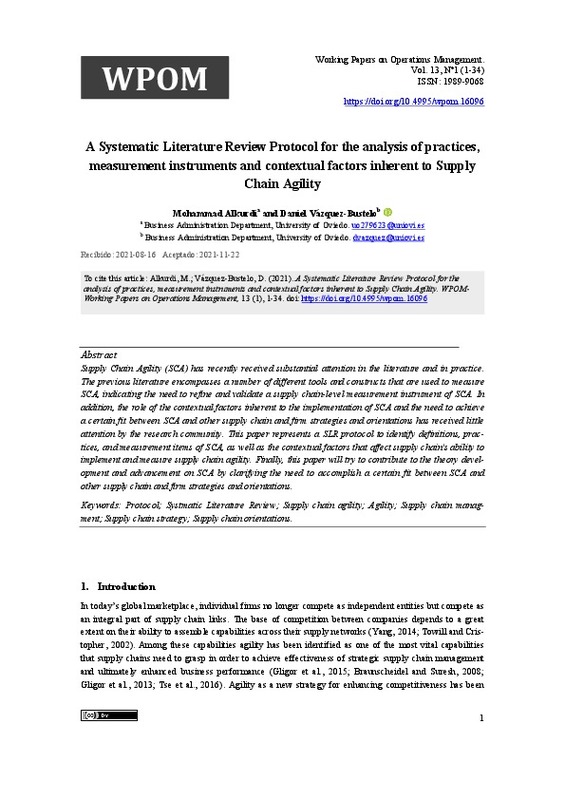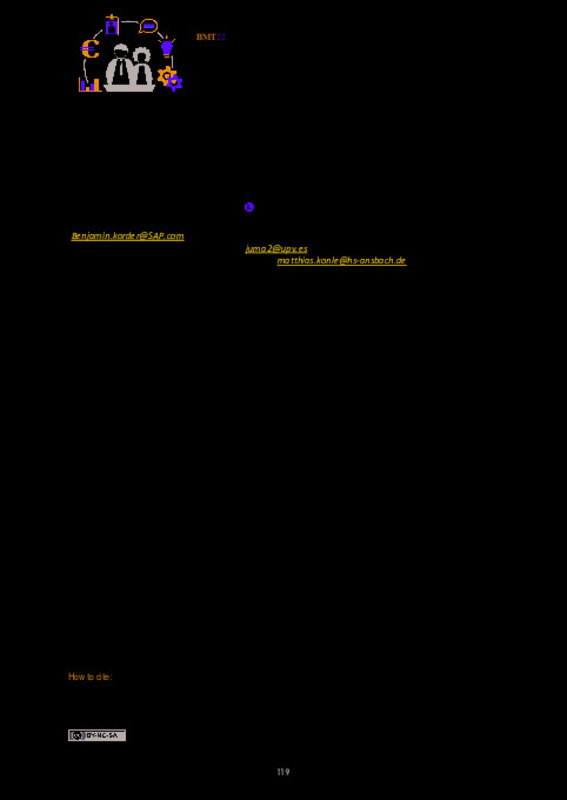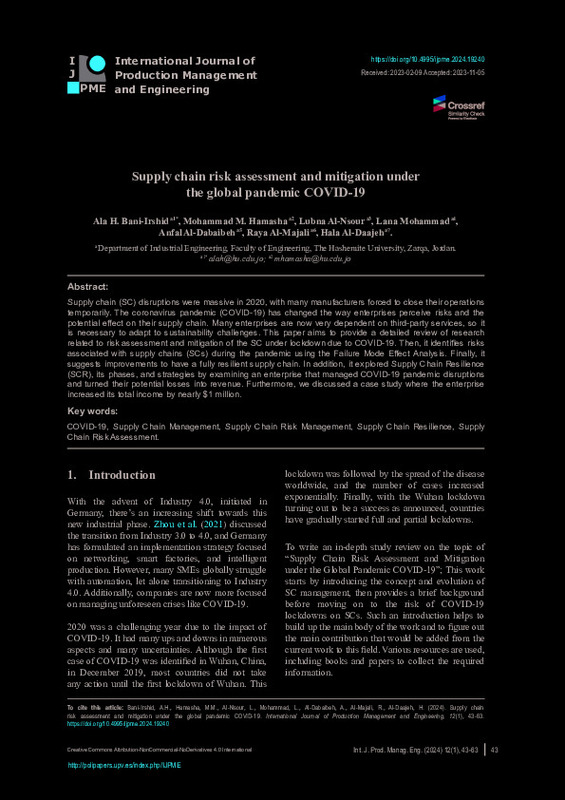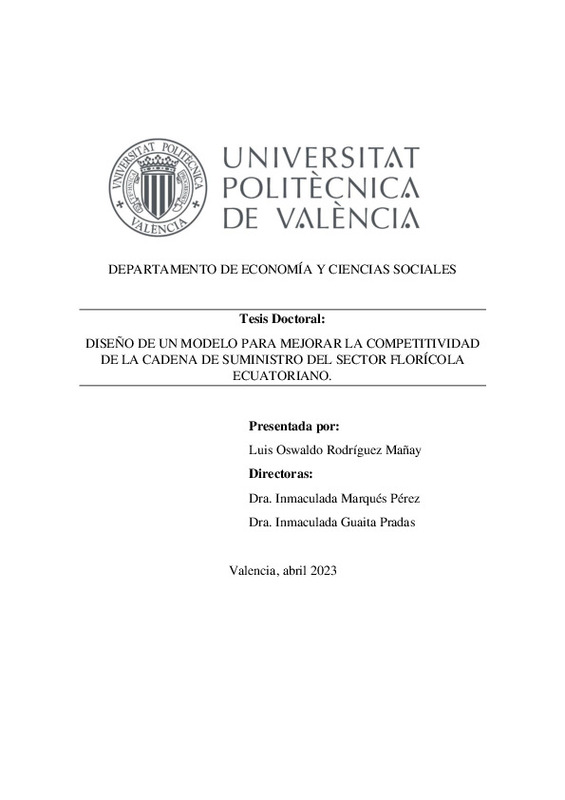Abdallah, A. B., & Nabass, I. H. (2018). Supply chain antecedents of agile manufacturing in a develop-ing country context. Journal of Manufacturing Technology Management, 29(6), 1042-1064. https://doi.org/10.1108/JMTM-01-2018-0019
Abdelilah, B., Korchi, A. E., & Balambo, M. A. (2018). Flexibility and agility: evolution and relation-ship. Journal of Manufacturing Technology Management, 29(7), 1138-1162. https://doi.org/10.1108/JMTM-03-2018-0090
Agarwal, A., Shankar, R., & Tiwari, M. (2007). Modeling agility of supply chain. Industrial Marketing Management, 36(4), 443-457. https://doi.org/10.1016/j.indmarman.2005.12.004
[+]
Abdallah, A. B., & Nabass, I. H. (2018). Supply chain antecedents of agile manufacturing in a develop-ing country context. Journal of Manufacturing Technology Management, 29(6), 1042-1064. https://doi.org/10.1108/JMTM-01-2018-0019
Abdelilah, B., Korchi, A. E., & Balambo, M. A. (2018). Flexibility and agility: evolution and relation-ship. Journal of Manufacturing Technology Management, 29(7), 1138-1162. https://doi.org/10.1108/JMTM-03-2018-0090
Agarwal, A., Shankar, R., & Tiwari, M. (2007). Modeling agility of supply chain. Industrial Marketing Management, 36(4), 443-457. https://doi.org/10.1016/j.indmarman.2005.12.004
Alfalla-Luque, R., Machuca, J. A. D., & Marin-Garcia, J. A. (2018). Triple-a and competitive advantage in supply chains: Empirical research in developed countries. International Journal of Production Economics, 203, 48-61. https://doi.org/10.1016/j.ijpe.2018.05.020
Altay, N., Gunasekaran, A., Dubey, R., & Childe, S. J. (2018). Agility and resilience as antecedents of supply chain performance under moderating effects of organizational culture within the humanitarian setting: a dynamic capability view. Production Planning & Control, 29(14), 1158-1174. https://doi.org/10.1080/09537287.2018.1542174
Aslam, H., Blome, C., Roscoe, S., & Azhar, T. M. (2018). Dynamic supply chain capabilities How market sensing, supply chain agility and adaptability affect supply chain ambidexterity. Interna-tional Journal of Operations & Production Management, 38(12), 2266-2285. https://doi.org/10.1108/IJOPM-09-2017-0555
Avelar-Sosa, L., García-Alcaraz, J., Mejía-Muñoz, J., Maldonado-Macías, A., & Hernández, G. (2018). Government Support and Market Proximity: Exploring Their Relationship with Supply Chain Agil-ity and Financial performance. Sustainability, 10(7), 2441. https://doi.org/10.3390/su10072441
Baramichai, M., Jr., E. W., & Marangos, C. (2007). Agile supply chain transformation matrix: a QFD-based tool for improving enterprise agility. International Journal of Value Chain Management, 1(3), 281. https://doi.org/10.1504/IJVCM.2007.013305
Bidhandi, R. A., & Valmohammadi, C. (2017). Effects of supply chain agility on profitability. Business Process Management Journal, 23(5), 1064-1082. https://doi.org/10.1108/BPMJ-05-2016-0089
Blome, C., Schoenherr, T., & Rexhausen, D. (2013). Antecedents and enablers of supply chain agility and its effect on performance: a dynamic capabilities perspective. International Journal of Produc-tion Research, 51(4), 1295-1318. https://doi.org/10.1080/00207543.2012.728011
Braunscheidel, M. J., & Suresh, N. C. (2008). The organizational antecedents of a firm's supply chain agility for risk mitigation and response. Journal of Operations Management, 27(2), 119-140. https://doi.org/10.1016/j.jom.2008.09.006
Brusset, X. (2016). Does supply chain visibility enhance agility? International Journal of Production Economics, 171, 46-59. https://doi.org/10.1016/j.ijpe.2015.10.005
Carvalho, A. M., Sampaio, P., Rebentisch, E., Carvalho, J. Á., & Saraiva, P. (2017). Operational excel-lence, organisational culture and agility: the missing link? Total Quality Management & Business Excellence, 30(13-14), 1495-1514. https://doi.org/10.1080/14783363.2017.1374833
Chan, A. T., Ngai, E. W., & Moon, K. K. (2017). The effects of strategic and manufacturing flexibilities and supply chain agility on firm performance in the fashion industry. European Journal of Opera-tional Research, 259(2), 486-499. https://doi.org/10.1016/j.ejor.2016.11.006
Chen, C.-J. (2019). Developing a model for supply chain agility and innovativeness to enhance firms' competitive advantage. Management Decision, 57(7), 1511-1534. https://doi.org/10.1108/MD-12-2017-1236
Degroote, S. E., & Marx, T. G. (2013). The impact of IT on supply chain agility and firm performance: An empirical investigation. International Journal of Information Management, 33(6), 909-916. https://doi.org/10.1016/j.ijinfomgt.2013.09.001
Dhaigude, A., & Kapoor, R. (2017). The mediation role of supply chain agility on supply chain orienta-tion-supply chain performance link. Journal of Decision Systems, 26(3), 275-293. https://doi.org/10.1080/12460125.2017.1351862
Du, Y., Hu, X., & Vakil, K. (2021). Systematic literature review on the supply chain agility for manu-facturer and consumer. International Journal of Consumer Studies, 45(4), 581-616. https://doi.org/10.1111/ijcs.12645
Dubey, R., Gunasekaran, A., & Childe, S. J. (2019). Big data analytics capability in supply chain agili-ty. Management Decision, 57(8), 2092-2112. https://doi.org/10.1108/MD-01-2018-0119
Durach, C. F., Kembro, J., & Wieland, A. (2017). A New Paradigm for Systematic Literature Reviews in Supply Chain Management. Journal of Supply Chain Management, 53(4), 67-85. https://doi.org/10.1111/jscm.12145
Eckstein, D., Goellner, M., Blome, C., & Henke, M. (2014). The performance impact of supply chain agility and supply chain adaptability: the moderating effect of product complexity. International Journal of Production Research, 53(10), 3028-3046. https://doi.org/10.1080/00207543.2014.970707
Faisal, M. N., Banwet, D. K., & Shankar, R. (2007). An approach to measure supply chain agility. International Journal of Industrial and Systems Engineering, 2(1), 79. https://doi.org/10.1504/IJISE.2007.011438
Fayezi, S., Zutshi, A., & Oloughlin, A. (2016). Understanding and Development of Supply Chain Agil-ity and Flexibility: A Structured Literature Review. International Journal of Management Reviews, 19(4), 379-407. https://doi.org/10.1111/ijmr.12096
Feizabadi, J., Maloni, M., & Gligor, D. (2019). Benchmarking the triple-A supply chain: orchestrating agility, adaptability, and alignment. Benchmarking: An International Journal, 26(1), 271-295. https://doi.org/10.1108/BIJ-03-2018-0059
Geyi, D. A. G., Yusuf, Y., Menhat, M. S., Abubakar, T., & Ogbuke, N. J. (2019). Agile capabilities as necessary conditions for maximising sustainable supply chain performance: An empirical investiga-tion. International Journal of Production Economics, 107501. https://doi.org/10.1016/j.ijpe.2019.09.022
Gligor, D. M. (2014). The role of demand management in achieving supply chain agility. Supply Chain Management: An International Journal, 19(5/6), 577-591. https://doi.org/10.1108/SCM-10-2013-0363
Gligor, D. M., & Holcomb, M. C. (2012). Understanding the role of logistics capabilities in achieving supply chain agility: a systematic literature review. Supply Chain Management: An International Journal, 17(4), 438-453. https://doi.org/10.1108/13598541211246594
Gligor, D. M., Esmark, C. L., & Holcomb, M. C. (2014). Performance outcomes of supply chain agili-ty: When should you be agile? Journal of Operations Management, 33-34(1), 71-82. https://doi.org/10.1016/j.jom.2014.10.008
Gligor, D. M., Holcomb, M. C., & Stank, T. P. (2013). A Multidisciplinary Approach to Supply Chain Agility: Conceptualization and Scale Development. Journal of Business Logistics, 34(2), 94-108. https://doi.org/10.1111/jbl.12012
Guner, H M., Çemberci, M., & Civelek, M. E. (2018). The effect of supply chain agility on firm per-formance. Journal of International Trade, Logistics and Law, 4(2), 25-34.
Hwang, T., & Kim, S. T. (2018). Balancing in-house and outsourced logistics services: effects on supply chain agility and firm performance. Service Business, 13(3), 531-556. https://doi.org/10.1007/s11628-018-00394-x
Ismail, H. S., & Sharifi, H. (2006). A balanced approach to building agile supply chains. International Journal of Physical Distribution & Logistics Management, 36(6), 431-444. https://doi.org/10.1108/09600030610677384
Jain, V., Benyoucef, L., & Deshmukh, S. G. (2008). A new approach for evaluating agility in supply chains using Fuzzy Association Rules Mining. Engineering Applications of Artificial Intelligence, 21(3), 367-385. https://doi.org/10.1016/j.engappai.2007.07.004
Khalili-Damghani, K., Taghavifard, M., Olfat, L., & Feizi, K. (2011). A hybrid approach based on fuzzy DEA and simulation to measure the efficiency of agility in supply chain: real case of dairy industry. International Journal of Management Science and Engineering Management, 6(3), 163-172. https://doi.org/10.1080/17509653.2011.10671160
Kim, M., & Chai, S. (2017). The impact of supplier innovativeness, information sharing and strategic sourcing on improving supply chain agility: Global supply chain perspective. International Journal of Production Economics, 187, 42-52. https://doi.org/10.1016/j.ijpe.2017.02.007
Li, X., Wu, Q., & Holsapple, C. W. (2015). Best-value supply chains and firms' competitive perfor-mance: empirical studies of their linkage. International Journal of Operations & Production Man-agement, 35(12), 1688-1709. https://doi.org/10.1108/IJOPM-01-2014-0014
Lin, C.-T., Chiu, H., & Chu, P.-Y. (2006). Agility index in the supply chain. International Journal of Production Economics, 100(2), 285-299. https://doi.org/10.1016/j.ijpe.2004.11.013
Liu, H., Ke, W., Wei, K. K., & Hua, Z. (2013). The impact of IT capabilities on firm performance: The mediating roles of absorptive capacity and supply chain agility. Decision Support Systems, 54(3), 1452-1462. https://doi.org/10.1016/j.dss.2012.12.016
Machuca, J. A. D., Marin-Garcia, J. A., & Alfalla-Luque, R. (2020). The country context in Triple-A Supply CHAINS: An advanced PLS-SEM research study in emerging vs developed countries. In-dustrial Management & Data Systems, 121(2), 228-267. https://doi.org/10.1108/IMDS-09-2020-0536
Margaret Weber, M. (2002). Measuring supply chain agility in the virtual organization. International Journal of Physical Distribution & Logistics Management, 32(7), 577-590. https://doi.org/10.1108/09600030210442595
Martin, C., & Towill, D. R. (2000). Supply chain migration from lean and functional to agile and cus-tomised. Supply Chain Management: An International Journal, 5(4), 206-213. https://doi.org/10.1108/13598540010347334
Martinez-Sanchez, A., & Lahoz-Leo, F. (2018). Supply chain agility: a mediator for absorptive capacity. Baltic Journal of Management, 13(2), 264-278. https://doi.org/10.1108/BJM-10-2017-0304
Mason-Jones, R., & Towill, D. R. (1999). Total cycle time compression and the agile supply chain. International Journal of Production Economics, 62(1-2), 61-73. https://doi.org/10.1016/S0925-5273(98)00221-7
Medina-Lopez, C., Marin-Garcia, J. A., & Alfalla-Luque, R. (2010). Una propuesta Metodológica para la realización de Búsquedas Sistemáticas de bibliografía (a methodological proposal for the systematic literature review). WPOM-Working Papers on Operations Management, 1(2), 13. https://doi.org/10.4995/wpom.v1i2.786
Mishra, S., Samantra, C., Datta, S., & Mahapatra, S. S. (2014). Agility appraisement framework for integrated supply chain using generalised interval-valued fuzzy set. International Journal of Busi-ness Information Systems, 16(1), 89. https://doi.org/10.1504/IJBIS.2014.060838
Nazempour, R., Yang, J., & Waheed, A. (2018). An Empirical Study to Understand the Effect of Supply Chain Agility on Organizational Operational Performance: SC Agility and Organizational Perfor-mance. International Journal of Information Systems and Supply Chain Management, 11(4), 1-20. https://doi.org/10.4018/IJISSCM.2018100101
Patel, B.S. & Sambasivan, M. (2021). A systematic review of the literature on supply chain agility. Management Research Review, Vol. ahead-of-print No. ahead-of-print. https://doi.org/10.1108/MRR-09-2020-0574
Pantouvakis, A., & Bouranta, N. (2015). Agility, organisational learning culture and relationship quality in the port sector. Total Quality Management & Business Excellence, 28(3-4), 366-378. https://doi.org/10.1080/14783363.2015.1084871
Pettit, T. J., Croxton, K. L., & Fiksel, J. (2013). Ensuring supply chain resilience: Development and implementation of an assessment tool. Journal of Business Logistics, 34(1), 46-76. https://doi.org/10.1111/jbl.12009
Power, D. J., Sohal, A. S., & Rahman, S. U. (2001). Critical success factors in agile supply chain man-agement ‐ An empirical study. International Journal of Physical Distribution & Logistics Man-agement, 31(4), 247-265. https://doi.org/10.1108/09600030110394923
Qi, Y., Zhao, X., & Sheu, C. (2011). The Impact of Competitive Strategy and Supply Chain Strategy on Business Performance: The Role of Environmental Uncertainty*. Decision Sciences, 42(2), 371-389. https://doi.org/10.1111/j.1540-5915.2011.00315.x
Qrunfleh, S., & Tarafdar, M. (2014). Supply chain information systems strategy: Impacts on supply chain performance and firm performance. International Journal of Production Economics, 147, 340-350. https://doi.org/10.1016/j.ijpe.2012.09.018
Roscoe, S., Eckstein, D., Blome, C., & Goellner, M. (2019). Determining how internal and external process connectivity affect supply chain agility: a life-cycle theory perspective. Production Planning & Control, 31(1), 78-91. https://doi.org/10.1080/09537287.2019.1629704
Russell, D. M., & Swanson, D. (2019). Transforming information into supply chain agility: an agility adaptation typology. The International Journal of Logistics Management, 30(1), 329-355. https://doi.org/10.1108/IJLM-09-2017-0237
Sabegh, M. H. Z., Caliskan, A., Ozturkoglu, Y., & Cetiner, B. (2018). Testing the Effects of Agile and Flexible Supply Chain on the Firm Performance Through SEM. System Performance and Manage-ment Analytics Asset Analytics, 35-46. https://doi.org/10.1007/978-981-10-7323-6_3
Samantra, C., Datta, S., Mishra, S., & Mahapatra, S. S. (2013). Agility appraisal for integrated supply chain using generalized trapezoidal fuzzy numbers set. The International Journal of Advanced Man-ufacturing Technology, 68(5-8), 1491-1503. https://doi.org/10.1007/s00170-013-4937-6
Sanchez-Ruiz, L., Marin-Garcia, J. A., & Blanco, B. (2018). Protocol: A Meta-Review on continuous improvement to know the state of this research field. WPOM-Working Papers on Operations Man-agement, 9(2), 88. https://doi.org/10.4995/wpom.v9i2.10752
Sellitto, M. A., Hermann, F. F., Blezs, A. E., & Barbosa-Póvoa, A. P. (2019). Describing and organiz-ing green practices in the context of Green supply CHAIN Management: Case studies. Resources, Conservation and Recycling, 145, 1-10. https://doi.org/10.1016/j.resconrec.2019.02.013
Sharifi, H., Ismail, H. S., & Reid, I. (2006). Achieving agility in supply chain through simultaneous "design of" and "design for" supply chain. Journal of Manufacturing Technology Management, 17(8), 1078-1098. https://doi.org/10.1108/17410380610707393
Sharma, N., Sahay, B. S., Shankar, R., & Sarma, P. R. S. (2017). Supply chain agility: review, classi-fication and synthesis. International Journal of Logistics Research and Applications, 20(6), 532-559. https://doi.org/10.1080/13675567.2017.1335296
Shekarian, M., Nooraie, S. V. R., & Parast, M. M. (2019). An examination of the impact of flexibility and agility on mitigating supply chain disruptions. International Journal of Production Economics, 107438. https://doi.org/10.1016/j.ijpe.2019.07.011
Siddhartha, N., & Sachan, A. (2016). Review of agile supply chain implementation frameworks. Interna-tional Journal of Business Performance and Supply Chain Modelling, 8(1), 27. https://doi.org/10.1504/IJBPSCM.2016.075999
Swafford, P. M., Ghosh, S., & Murthy, N. (2006). The antecedents of supply chain agility of a firm: Scale development and model testing. Journal of Operations Management, 24(2), 170-188. https://doi.org/10.1016/j.jom.2005.05.002
Tarafdar, M., & Qrunfleh, S. (2016). Agile supply chain strategy and supply chain performance: com-plementary roles of supply chain practices and information systems capability for agility. Interna-tional Journal of Production Research, 55(4), 925-938. https://doi.org/10.1080/00207543.2016.1203079
Tranfield, D., Denyer, D., & Smart, P. (2003). Towards a Methodology for Developing Evidence-Informed Management Knowledge by Means of Systematic Review. British Journal of Manage-ment, 14(3), 207-222. https://doi.org/10.1111/1467-8551.00375
Tse, Y. K., Zhang, M., Akhtar, P., & Macbryde, J. (2016). Embracing supply chain agility: an investi-gation in the electronics industry. Supply Chain Management: An International Journal, 21(1), 140-156. https://doi.org/10.1108/SCM-06-2015-0237
Tuan, L. T. (2016). Organisational ambidexterity and supply chain agility: the mediating role of external knowledge sharing and moderating role of competitive intelligence. International Journal of Logis-tics Research and Applications, 19(6), 583-603. https://doi.org/10.1080/13675567.2015.1137278
Um, J. (2016). The impact of supply chain agility on business performance in a high level customization environment. Operations Management Research, 10(1-2), 10-19. https://doi.org/10.1007/s12063-016-0120-1
Wu, T., Jim Wu, Y.-C., Chen, Y. J., & Goh, M. (2014). Aligning supply chain strategy with corporate environmental strategy: A contingency approach. International Journal of Production Economics, 147, 220-229. https://doi.org/10.1016/j.ijpe.2013.02.027
Yang, J. (2014). Supply chain agility: Securing performance for Chinese manufacturers. International Journal of Production Economics, 150, 104-113. https://doi.org/10.1016/j.ijpe.2013.12.018
Yusuf, Y. Y., Gunasekaran, A., Adeleye, E. O., & Sivayoganathan, K. (2004). Agile supply chain capa-bilities: Determinants of competitive objectives. European Journal of Operational Research, 159(2), 379-392. https://doi.org/10.1016/j.ejor.2003.08.022
[-]


 Vázquez-Bustelo, Daniel
Vázquez-Bustelo, Daniel










